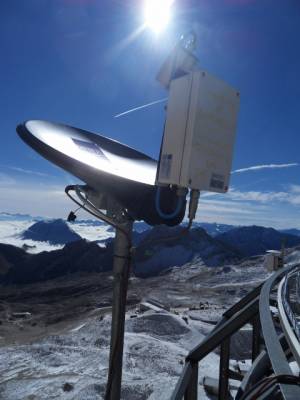Table of Contents
Micro Rain Radar (MRR) at UFS
Mentor: M. Maahn
INSTRUMENT IS REMOVED SINCE 09/2015
Principle
The Micro Rain Radar (MRR) is a vertically pointing FM-CW (frequency modulated continuous wave) Doppler radar operating at K-band (24.1 GHz, 12.4 mm wavelength). The emitted radar signal (only 50mW transmitting power) is backscattered by falling hydrometeors (rain, graupel, snow). From the Doppler spectra the radar reflectivity factor (Ze) and the terminal fall velocity distribution can be derived. The range resolution can be varied from 10 to 200m which determines together with the 30 range gates the system's maximum height range of 300-6000 m. In case of rain the Doppler spectra can be used to derive vertical profiles of microphysical rain properties like drop size distribution and rain rate. Recently, the MRR system was also studied for its potential to observe snowfall link Kneifel et al. 2011. Also an improved MRR algorithm most suitable for snowfall observations has been developed at IGMK link and is also freely available here: IMProToo - Improved Mrr Processing Tool.
Instrument provided by Chris Kidd, U. Birmingham.
Instrument
History
| Period | Place |
|---|---|
| 09/2012 - 09/2015 | UFS Schneefernerhaus |
Data
Specifications
| Parameter | Specification |
|---|---|
| Frequency | 24.1 GHz |
| Wavel | 12.4 mm |
| Radar Type | FM-CW |
| Transmit Power | 50 mW |
| Receiver | Single Polarization |
| Power consumption (radar) | 25 W |
| Total power cons. incl heating | 525 W |
| Max. range | 6 km |
| Range Resolution | 10-200 m |
| No. of range gates | 30 |
| Temporal resolution | 10 s |
| Antenna diameter | 0.5 m |
| Beam width (2-way, 6 dB) | 1.5° |

